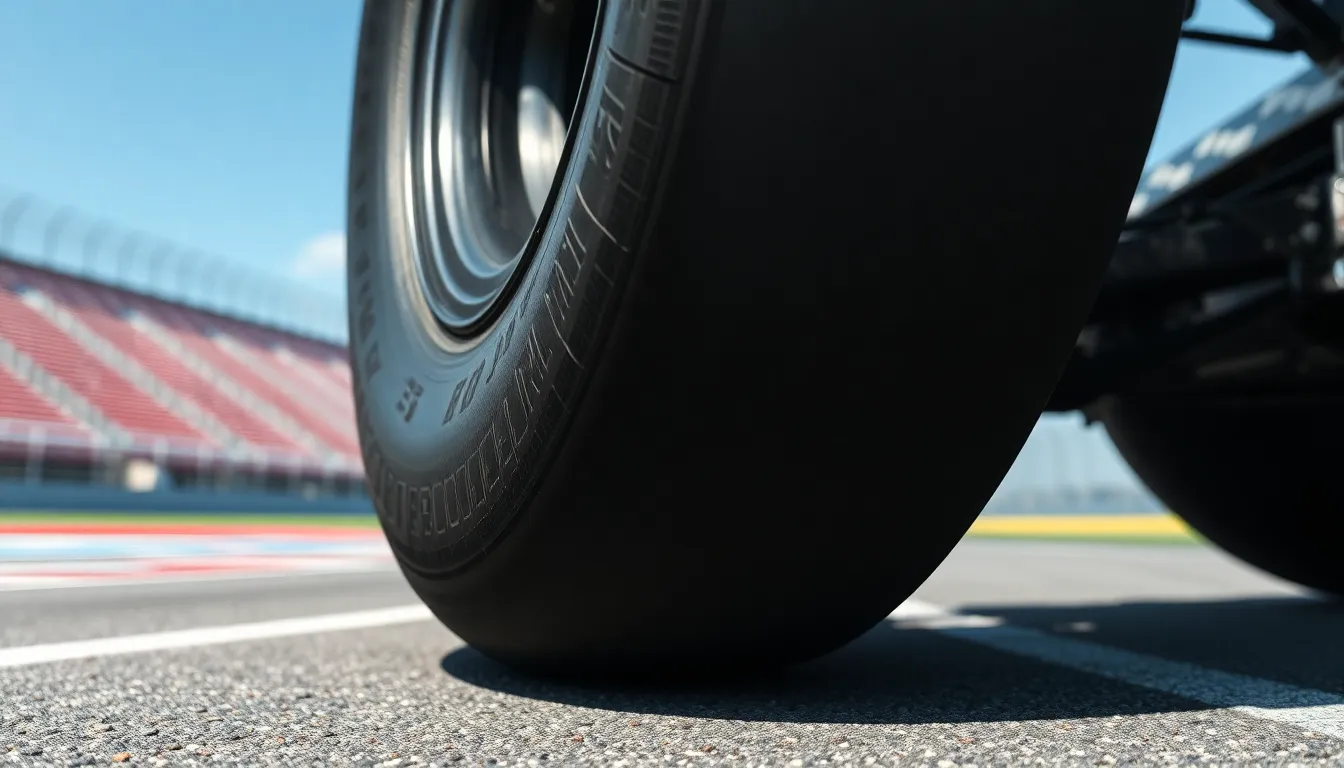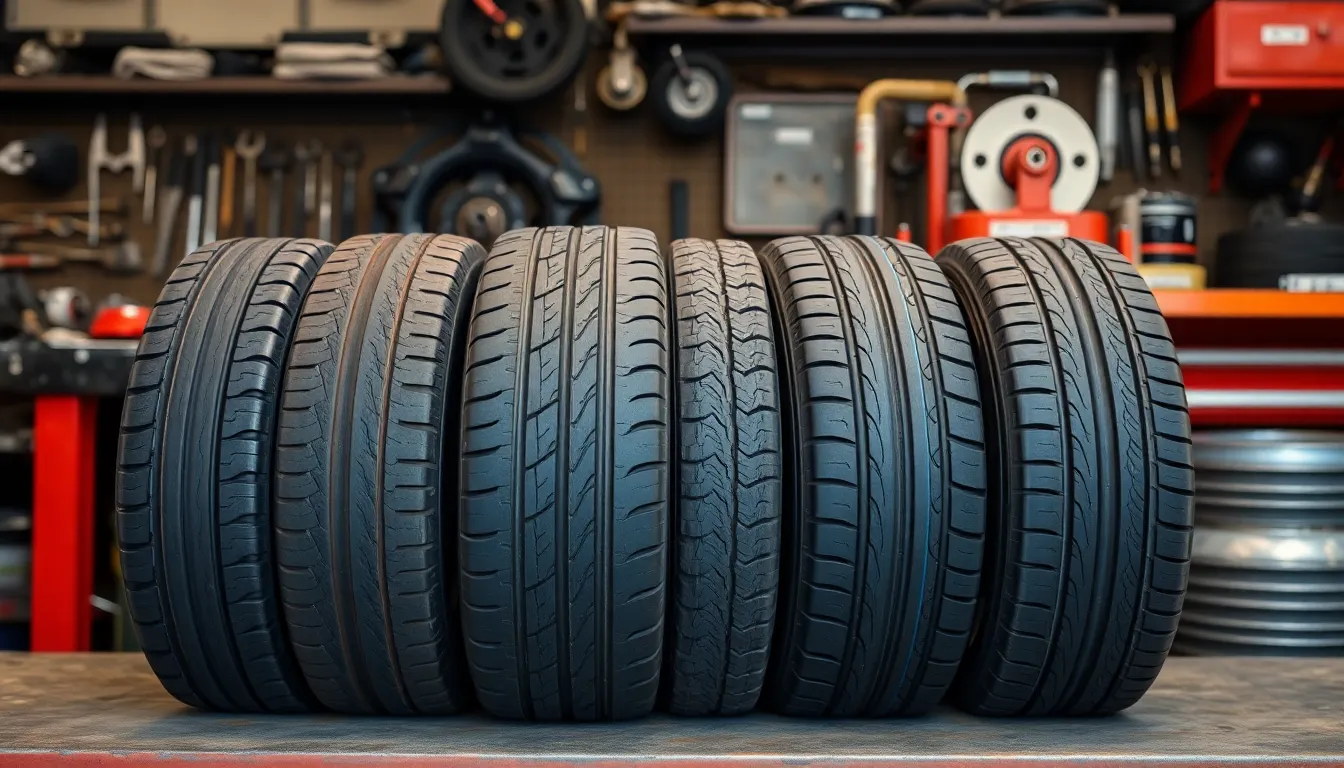When we’re shopping for new tires or upgrading our vehicle’s performance setup, understanding tire dimensions becomes crucial. The width of 305 tires is a common question we encounter, especially among truck owners and performance enthusiasts looking to enhance their ride’s capabilities.
We’ve all seen those bold numbers on tire sidewalls, but what do they actually mean? The “305” in a tire size represents the tire’s width in millimeters, but there’s more to the story than just that single measurement. Converting this to inches and understanding how it affects your vehicle’s performance can make the difference between a perfect fit and costly mistakes.
Whether you’re considering 305 tires for your truck, SUV, or sports car, we’ll break down everything you need to know about their actual width and how they’ll impact your driving experience. Let’s jump into the specifics and help you make an well-informed choice for your next tire purchase.
Understanding 305 Tire Width Measurements
The number 305 represents the tire’s width measurement in millimeters from sidewall to sidewall when mounted on the recommended rim width. Converting 305 millimeters to inches gives us approximately 12.01 inches of tire width. This measurement follows the standardized tire sizing system established by the Tire and Rim Association.
Tire manufacturers measure width at the tire’s widest point when properly inflated and mounted on the specified rim width. The actual contact patch width varies based on several factors including rim width, tire construction, and inflation pressure. Most 305 tires mount optimally on rim widths ranging from 9.5 to 11.5 inches.
| Measurement Type | Value |
|---|---|
| Millimeter Width | 305 mm |
| Inch Width | 12.01 inches |
| Minimum Rim Width | 9.5 inches |
| Maximum Rim Width | 11.5 inches |
| Optimal Rim Width | 10.5 inches |
Different rim widths affect how the tire sits and performs on your vehicle. Narrower rims create a more rounded tire profile while wider rims produce a squarer contact patch. The sidewall construction also influences the tire’s actual footprint on the road surface.
We measure tire width perpendicular to the tire’s centerline at its maximum section width. This measurement occurs when the tire maintains proper air pressure and sits on its designated rim size. Understanding these specifications helps us select appropriate tires for exact vehicle applications and performance requirements.
How Wide Are 305 Tires in Inches and Millimeters

305 tires measure exactly 305 millimeters across their tread width, which translates to approximately 12 inches when converted to imperial measurements. This standardized measurement provides the foundation for understanding how these tires perform across different vehicle applications.
Converting 305mm to Inches
Mathematical conversion from millimeters to inches uses the standard ratio where 1 inch equals 25.4 millimeters. Dividing 305 by 25.4 gives us 12.01 inches as the precise width measurement for 305 tires.
| Measurement Type | Metric Value | Imperial Value |
|---|---|---|
| Tire Width | 305 mm | 12.01 inches |
| Conversion Factor | 25.4 mm | 1 inch |
Performance enthusiasts often reference this 12-inch width when comparing tire options, as it represents a substantial contact area for traction and stability. Commercial tire manufacturers consistently use this millimeter-to-inch conversion across all tire specifications to maintain global standardization.
Actual Contact Patch Width
Contact patch width differs significantly from the nominal tire width due to several mechanical factors. Tire pressure, vehicle load, and tread pattern design all influence how much of the 305mm width actually touches the road surface.
Real-industry contact patches typically measure narrower than the full 12-inch tire width, often ranging between 8 to 10 inches depending on operating conditions. Load distribution across the tire footprint creates varying pressure points that affect the effective contact area.
Sidewall construction and tire compound flexibility also impact contact patch characteristics, with stiffer sidewalls maintaining more consistent contact width under cornering forces. Racing applications often optimize contact patch width through exact tire pressure adjustments to maximize grip performance within the 305mm tire platform.
Comparing 305 Tires to Other Common Tire Sizes

Understanding how 305 tires compare to other popular tire widths helps us make informed decisions when upgrading or replacing tires. These comparisons reveal important differences in performance characteristics and fitment requirements.
305 vs 295 Tires
Width difference: 305 tires measure 305mm (12 inches) while 295 tires measure 295mm (11.6 inches), creating a 10mm (0.4 inch) gap between these sizes.
Contact patch benefits: The additional width in 305 tires provides approximately 3.4% more contact area than 295 tires, translating to improved traction during acceleration and cornering.
Performance impact: Vehicles equipped with 305 tires experience enhanced grip compared to 295 alternatives, though they also generate slightly more rolling resistance and road noise.
Fitment considerations: Both tire sizes often share similar rim width requirements, making 305 tires a direct upgrade option for vehicles currently running 295 tires.
305 vs 315 Tires
Size comparison: 315 tires measure 315mm (12.4 inches) in width, making them 10mm (0.4 inch) wider than 305 tires across the tread surface.
Rim requirements: 315 tires typically require wider rim widths compared to 305 tires, with maximum fitment ranging up to 12.5 inches versus 12 inches for most 305 applications.
Performance characteristics: The wider 315 profile delivers superior traction capabilities but increases fuel consumption and generates more road noise than 305 tires.
Vehicle compatibility: Many vehicles that accommodate 305 tires can also fit 315 tires, though clearance checks for wheel wells and suspension components become critical.
305 vs 285 Tires
Substantial width difference: 285 tires measure 285mm (11.2 inches), creating a important 20mm (0.8 inch) width gap compared to 305 tires.
Traction advantages: The wider 305 profile provides approximately 7% more contact patch area than 285 tires, resulting in noticeably improved grip performance.
Handling characteristics: Vehicles upgrading from 285 to 305 tires experience enhanced cornering stability and reduced tire flex during aggressive driving maneuvers.
Cost considerations: The price difference between 285 and 305 tires can be substantial, with 305 tires typically commanding premium pricing due to their specialized applications.
| Tire Size | Width (mm) | Width (inches) | Difference from 305 |
|---|---|---|---|
| 285 | 285 | 11.2 | -0.8 inches |
| 295 | 295 | 11.6 | -0.4 inches |
| 305 | 305 | 12.0 | Reference |
| 315 | 315 | 12.4 | +0.4 inches |
Factors That Affect Actual 305 Tire Width

Several variables influence how a 305 tire’s actual width performs once mounted on your vehicle. Understanding these factors helps optimize tire performance and ensures proper fitment for your exact application.
Rim Width Impact on Tire Width
Rim width significantly affects how your 305 tire’s contact patch spreads across the road surface. A rim width between 8 to 10 inches provides optimal performance for most 305 tire applications, though exact designs may require different specifications.
Narrower rims create a more rounded tire profile that concentrates the contact patch toward the center of the tread. This configuration improves ride comfort but may reduce cornering stability during aggressive driving maneuvers.
Wider rims stretch the tire sidewalls outward, creating a squarer contact patch that maximizes tread surface contact with the road. Performance enthusiasts often choose wider rim configurations to enhance grip characteristics and steering response precision.
Extreme rim width variations can negatively impact tire longevity and handling characteristics. Mounting a 305 tire on rims outside the manufacturer’s recommended range may cause uneven wear patterns and compromised structural integrity.
Tire Pressure Effects
Tire pressure directly influences your 305 tire’s actual contact width and overall performance characteristics. Higher pressure reduces the tire’s footprint by causing less sidewall flex and creating a narrower contact patch.
Lower pressure increases the contact area by allowing more sidewall deflection, which enhances traction but may compromise handling precision. Racing applications often use pressure adjustments to fine tune grip levels for exact track conditions.
Optimal pressure settings for 305 tires typically range from 32 to 40 PSI depending on vehicle weight and intended use. Commercial truck applications may require higher pressures to support increased load ratings.
Temperature changes affect tire pressure by approximately 1 PSI per 10 degree Fahrenheit variation. Monitoring pressure regularly ensures consistent performance and prevents premature wear patterns.
Manufacturer Variations
Different tire manufacturers produce 305 tires with slight dimensional variations even though using the same size designation. These differences stem from unique tread patterns, sidewall construction methods, and rubber compound formulations.
Brand exact design philosophies create measurable width variations typically ranging within 2 to 5 millimeters of the nominal 305mm specification. Performance oriented manufacturers may prioritize maximum contact area while comfort focused brands emphasize sidewall flexibility.
Construction techniques like radial belt angles and ply arrangements influence how the tire maintains its shape under load. Some manufacturers use reinforced sidewall designs that resist deformation better than standard construction methods.
Quality control standards vary between manufacturers, resulting in batch to batch consistency differences. Premium tire brands typically maintain tighter dimensional tolerances compared to economy alternatives.
Popular 305 Tire Applications and Vehicle Types

The versatility of 305 tires makes them suitable for diverse automotive applications. Different vehicle categories use these 12-inch wide tires to achieve exact performance objectives.
Performance Cars and Sports Vehicles
High-performance vehicles frequently use 305 width tires to maximize contact area and enhance grip characteristics. Sports coupes, muscle cars, and supercars commonly feature these wide tires on their rear axles to optimize traction during acceleration phases.
Racing applications benefit significantly from the increased contact patch that 305 tires provide. Track-focused vehicles require maximum grip for cornering stability and straight-line acceleration performance.
Performance enthusiasts choose 305 tires when upgrading their vehicles for enhanced handling capabilities. The wider footprint delivers improved steering response and reduced tire slip during aggressive driving maneuvers.
Trucks and SUVs
Full-size trucks and large SUVs represent the primary market segment for 305 width tires. Heavy-duty pickups commonly use tire sizes like 305/70R18 to support substantial payload capacities and towing requirements.
Off-road vehicles benefit from the stability that 305 tires provide on challenging terrain. The wider contact area distributes vehicle weight more effectively across loose surfaces like sand, gravel, and mud.
Commercial truck applications use 305 tires to handle increased load demands while maintaining ride quality. Fleet operators choose these tires for their durability and ability to support heavier cargo weights consistently.
Rim width requirements for 305 tires typically range from 8 to 10.5 inches depending on the exact tire construction and intended application. Proper rim selection ensures optimal tire performance and longevity across all vehicle types.
Pros and Cons of 305 Wide Tires

We’ve examined the technical specifications of 305 tires and their mounting requirements. Understanding the advantages and disadvantages of these wide tires helps determine whether they’re the right choice for your vehicle application.
Performance Benefits
Traction improvements represent the most important advantage of 305 wide tires. The larger contact area boosts grip on various surfaces including wet roads and off-road terrain. Racing applications particularly benefit from this increased surface contact which can reduce lap times by 0.5 to 1.2 seconds on a typical road course.
Handling characteristics improve dramatically with 305 tires compared to narrower alternatives. Wider tires can improve cornering stability and reduce lateral slip during aggressive driving maneuvers. Cornering forces increase by approximately 15-20% when upgrading from 285 to 305 width tires on equivalent rim setups.
Load capacity increases with the additional width make 305 tires ideal for trucks and SUVs. These tires typically support 25-35% more weight than their narrower counterparts. Heavy-duty applications benefit from the distributed load across the wider footprint which reduces individual tire stress.
Appearance enhancement gives vehicles a more aggressive and performance-oriented look. The wider stance creates a planted appearance that many enthusiasts prefer. Show vehicles and custom builds frequently specify 305 tires for their visual impact.
Potential Drawbacks
Fuel economy reduction occurs due to increased rolling resistance from the wider contact patch. The added rolling resistance can decrease miles per gallon by 3-8% depending on driving conditions and vehicle weight. Highway driving typically shows less impact than city driving with frequent acceleration cycles.
Compatibility issues arise when vehicles lack adequate clearance for 305 width tires. Some vehicles require fender modifications or different suspension setups to accommodate these wider tires. Wheel well clearance becomes critical especially during suspension compression and steering lock situations.
Cost considerations include both tire prices and installation requirements. Wider tires and necessary wheel or suspension changes can be 40-60% more expensive than standard width alternatives. Replacement costs also increase as 305 tires typically wear faster in daily driving conditions due to their performance-oriented compound formulations.
Road noise levels increase with wider tires due to the larger contact patch interacting with road surfaces. The noise difference becomes most noticeable at highway speeds where wind noise previously masked tire noise. Premium tire brands minimize this effect through advanced tread pattern designs.
Conclusion
We’ve covered the essential details about 305 tire width to help you make the best choice for your vehicle. At 12.01 inches wide these tires offer impressive performance benefits that make them popular among truck owners and performance enthusiasts alike.
Remember that actual performance depends on several factors beyond just width including rim selection tire pressure and your exact vehicle requirements. While 305 tires deliver excellent traction and handling they do come with trade-offs in fuel economy and cost.
Whether you’re upgrading your truck for better load capacity or improving your sports car’s grip understanding these specifications ensures you’ll get the performance you’re looking for. Take time to consider your driving needs and consult with tire professionals to maximize your investment.
Frequently Asked Questions
How wide is a 305 tire in inches?
A 305 tire measures approximately 12.01 inches wide. The number 305 represents the tire’s width in millimeters from sidewall to sidewall when mounted on the recommended rim width. This measurement is taken at the tire’s widest point when properly inflated and mounted on the specified rim width.
What rim width is best for 305 tires?
The optimal rim width for 305 tires ranges from 9.5 to 11.5 inches, with most applications working best between 8 to 10 inches. Narrower rims create a more rounded tire profile for better ride comfort, while wider rims produce a squarer contact patch that maximizes tread surface contact and improves grip performance.
How do 305 tires compare to 295 tires?
305 tires are 10mm wider than 295 tires and provide approximately 3.4% more contact area, resulting in enhanced traction. However, this increased width also leads to slightly higher rolling resistance and road noise compared to 295 tires. The wider footprint offers better grip but may reduce fuel economy.
What vehicles commonly use 305 tires?
305 tires are popular on high-performance vehicles like sports cars and muscle cars, full-size trucks and SUVs, and racing applications. They’re ideal for vehicles requiring maximum grip, heavy payload support, or enhanced cornering stability. These tires work well on vehicles that can accommodate the wider footprint and associated performance characteristics.
What are the main disadvantages of 305 tires?
The primary drawbacks of 305 tires include reduced fuel economy due to increased rolling resistance, higher purchase costs, increased road noise, and potential compatibility issues with certain vehicles. They may also require wider rims and can be more challenging to find replacement options compared to standard tire sizes.
Do all 305 tires have the exact same width?
No, different tire manufacturers may produce 305 tires with slight dimensional variations ranging from 2 to 5 millimeters from the nominal specification. These differences result from unique tread patterns, sidewall construction, and rubber compounds used by each manufacturer, which can affect the tire’s actual mounted width and performance characteristics.

